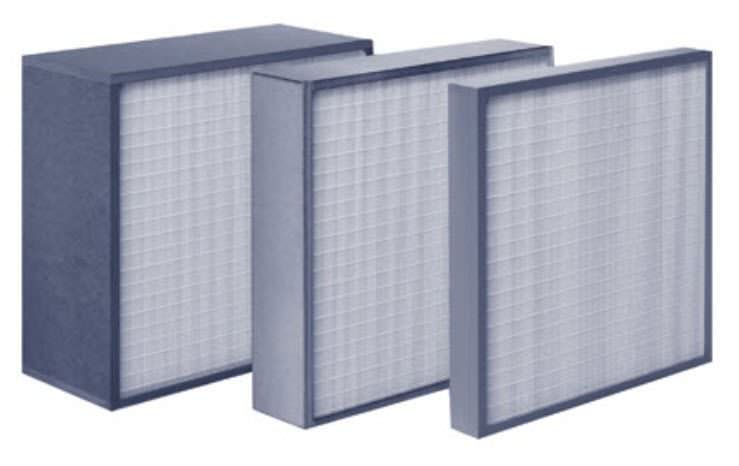If you want to improve the quality of air inside your home, then you will need a high-quality air purifier. A high-quality air purifier can reduce the quantity of airborne allergens which can antagonize common allergies and asthma. Basically, an air purifier takes the dirty air, eliminates the contaminants, and produces a flow of clean, healthy air in your home. The type of filter fitted in an air purifier unit will determine the process of air purification and also how well the air purifier performs.

HEPA Filters
High-efficiency particulate absorption (HEPA) air filters were first invented in the 1940s when the US Atomic Energy Commission used them to try and filter radioactive contaminants. In order to qualify as a HEPA filter, the filter must be able to capture no less than 99.97% of pollutants at 0.3 microns.
The process of filtration, using a HEPA, is able to capture particles which are 25-50 times smaller than the human eye can detect. HEPA filters contain ultra-fine fibers which capture microscopic particles using a combination of three different methods: diffusion, interception, and inertial impaction. Diffusion happens with smaller particles when their random movements cause them to collide with the fibers. Interception happens when larger particles collide directly with the fibers. Inertial impaction happens when the inertia of a particle leads to it colliding with the fibers.
HEGA Filters
High Efficiency Gas Adsorber filters must have a minimum efficiency of 99.9% according to the standards set out by the Institute of Environmental Sciences. This type of filter uses “adsorber” filtration in order to remove chemicals, gases, and odors.
Adsorbing is a process where carbon or carbon/zeolite pellets in a carbon cloth filter capture gaseous particles. In the case of a HEGA filter, the filtration process and filter must meet specific standards. A HEGA filter must be able to capture and remove irritants such as: bacteria, pollen, dust, mold spores and pet dander.
Activated Carbon Filters
This type of filter is able to remove gases, chemical toxins and odors. The filter is made of oxygen-treated carbon or activated charcoal which opens up millions of tiny pores between the carbon atoms which act as filters.
Odorous substances from gases or liquids are adsorbed by the activated charcoal. Adsorbing describes the way in which pollutants attach themselves to the charcoal through a process of chemical attraction. The activated charcoal has a large surface, which provides thousands of pores for trapping pollutants as they pass over its surface.
In some cases, additional chemicals such as potassium iodide and potassium permanganate are used to treat the carbon filter to improve its performance in capturing VOCs and various other chemically reactive gases. A wider range of contaminants can be adsorbed by carbon active filters.
Electrostatic Filters
Similar to activated carbon filters – electrostatic filters trap pollutants by attracting them. In place of carbon, an electrostatic filter uses electrostatic charges to purify the air. The electrostatic charges are produced by forcing air through a maze of stationery prone fibers. When the airborne particles travel over the static prone fibers, the static charge attracts them, and effectively captures them in the filter. The trapped particles gather on special collector plates and are then removed by hand washing or a HEPA vacuum cleaner.
By using static electricity, the filters never have to be replaced, because the collection plates can be easily cleaned. However, for optimal performance the collection plates should be cleaned often. One drawback to some electrostatic filters is that they emit ozone. This can be a dangerous irritant to the lungs which may set off asthma and allergy symptoms, in addition to various other respiratory conditions.
Charged Media Filters
This type of filter also uses electrostatic energy. It is manufactured using synthetic fibers and during the manufacturing process the media filter is electrically charged and maintains the charge while it is in use. It is this charge which attracts airborne particles, charging them electrostatically and subsequently capturing them inside the fibers of a traditional filter.
The main benefit of charged media filters is that they are extremely efficient and cost effective to run. However, when the filter becomes dirty, its resistance to airflow increases which makes it less efficient. Therefore, charged media filters need to be regularly replaced to maintain optimal performance.
Charged media air purifiers are known to be energy-efficient and quiet in operation. However, some units may emit ozone.
Hybrid Air Filtration Systems
This type of filter maximizes its efficiency by using multiple technologies. A Hybrid air purifier uses a mixture of filtering methods, each of the filters contributing to the general quality of the air it produces. The most effective air purifier units on the market consist of a combination of the filter types described above.
This combination of air filters is the next evolutionary step to improving indoor air quality. However, different filter types have their own unique strengths in terms of air purifying. When you are selecting an air purifier it is important you are clear about your air cleaning needs and do your research so you can choose the type of air purifier and filter system that is best for your needs and circumstances.
